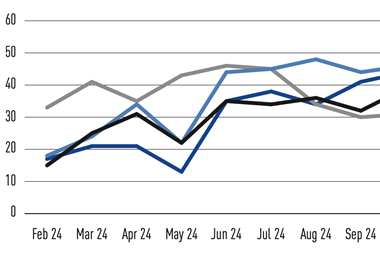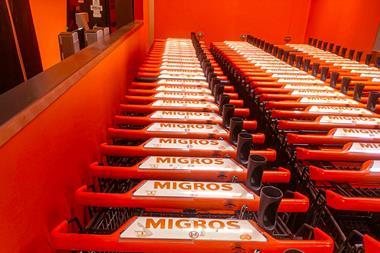For most people, responsibility for one large corporate pension scheme would be more than enough. Jerry Ryan, group secretary at Irish telecommunications giant Eircom, however, has two. The reason for his expanded pensions portfolio derives from the history of an organisation, which started life as the Irish phone operator, Telecom Eireann.
Until 1984, telecommunications was part of a government department, then it became a ‘semi state body’ – a limited company, with the government owning all the shares. This meant forming a new pension scheme, as employees were up to then covered by the Irish civil service scheme.
In 1999, using proceeds from the sale of Telecom Eireann (then renamed Eircom) the company set up a second pension fund to cover these pre-1984 liabilities for pension entitlement relating to the civil service scheme prior to 1984 (now known as the number two fund).
However, as Ryan points out: “The number two fund is now actually a closed fund.” For each fund, he notes that there are separate sets of trustees and different investment strategies.
Contributions for the main fund come out at a company rate of 8.2% of remuneration, while employees contribute 5.3%. Ryan says that the employee contribution to the main scheme only began around the time of the IPO.
The main fund currently holds assets of e1.8bn and unlike the number two fund, is still open to joiners. The plan has 19,000 members of which 5,000 are pensioners and 4,000 deferred.
Investment arrangements for the fund comprised an asset allocation mix of 65% in equity and 18% in fixed interest at the end of December 2002.
These assets are managed by five investment managers: Bank of Ireland Asset Management holds a balanced portfolio of e500m, Irish Life has a consensus fund of e350m, AIB also has around e300m in a balanced mandate, KBC has e100m in a balanced fund and Wellington runs a specialist international equity brief of e200m. “In addition to that we have direct holdings in property of about e300m, which we run in-house,” says Ryan. “We have a property manager who is an external agent, but is completely separate from the other investment manager arrangements.”
Ryan points out that all the property holdings in the main fund are in Ireland. Interestingly, the scheme also makes an allocation of around e20m to venture capital, as Ryan explains: “We have had this money in different venture funds since 1984 and it has been reasonably successful for us.
“There are a number of providers in the Irish market and we started this allocation in 1984 with very small amounts before moving into a follow up fund in 1999.
“It’s a tough sector to make money in but it’s going OK – it’s certainly not as easy to get good returns as it was before. However, we would regard this as a positive learning curve.”
Another singular area the fund invests in is forestry, through the Irish Forestry Unit Trust (IFUT). “Forestry is a long-term investment. We would regard it akin to property in a way that it is a variation for the other asset classes.
“Aside from investment, it has a lot of positive connotations as well in that it creates employment, is a green investment and is locally based.”
Regarding other alternative asset classes, Ryan notes that the fund is actively looking to invest more money: “We haven’t made up our mind up how this will be done and we are still investigating, but our methodology will be very prudent as usual. We’ll put a toe in the water and see how it goes.”
Ryan says he believes this approach reflects the fund’s general stance on investment: “I think you have to be open. For example, when we got involved with Wellington four or five years ago it was fairly unusual for an Irish fund to hire a specialist international equity manager. “Again we took it a step at a time and it has worked out pretty well for us and we’ve given them additional money over time.”
About three years ago, Eircom selected Citibank as custodian for the number two fund, an arrangement that has prompted the main plan to go down a similar path. “We have decided that in principle we will also go ahead with a global custody arrangement for the main fund and we are in negotiations at the moment with a provider.”
Ryan points out that unlike Eircom’s main fund which has been growing since 1984, in the case of the number two fund a lump sum was put up to cover the pre-1984 liabilities. The investment strategy was then designed with this in mind. “The number two fund did an ALM study and came up with a slightly different investment strategy.”
BGI has a chunk of the fund - around 40% – in global index mandates, both in equities and fixed income.
On top of that, the fund has two specialist equity mandates, one e85m brief with Alliance Bernstein and another specialist global equity brief for e135m with Fidelity. Both mandates are benchmarked depending on the market they invest in.
“The main point here is that they are not judged by peer group comparison like the main fund, although the main plan is moving away from that approach as well,” says Ryan. KBC also manages a balanced mandate for the number two scheme.
In a recent move the number two fund, with e650m in assets, also began looking to broaden its property focus: “The target is to have 7.5% in real estate. “At the moment we have about a 5% allocation, or e35m, 40% of which is in the Irish market, with the other 60% in euro property funds. When we first looked at how we would do this we spoke to a number of different funds for advice. As I mentioned before, this prudent approach is a characteristic of everything we do,” Ryan comments.
Despite the different investment approaches to the two funds, he points out that there are increasing similarities. “We try as best as we can to be up to date with the latest investment strategies and then we relate that to each fund in turn.
“Additionally, we use the experience we gain with one fund to help us in other situations.” One area where the two funds do share very physical ties is on administration, which is carried out in-house. “We have around 5,000 pensioners, so it is a big payroll and about 4,000 deferred members who will receive benefit at age 60.”
The principles for management of the two funds also follow similar lines with trustees holding investment reviews every quarter by trustees and strategy looked at definitively every three years. “We also look at strategy on a more regular basis and if we weren’t happy with a manager, for example, then we would look very quickly at sorting that out.”
In terms of consultancy, Eircom has in-house expertise to take care of much of the investment analysis.
Above and beyond the two main Eircom pension funds, there is also a DC arrangement, with just E20m in assets. “The DB fund is still open but there are very few joiners now, so we have a standard DC fund in place with contributions roughly split 10% from the employer and 5% from the employee.
“There are six to seven investment options on the equity risk scale and we offer employees professional advice as to which option they might take.”
The admin for the DC plan is carried out externally and the fund has about 700 members after four years of existence. “The investment is through managed fund products and we negotiate a reduction of fee depending on scale. Setanta Investment Management run this and offer some other fund products through the structure.”
Going forward, Ryan says the issues facing the main fund will be its maturity and lack of new members. “We’ll have to be looking at the investment profile to make sure it is appropriate. Also the issue of having large numbers of deferred members has implications for the investment strategy going forward.”
For the man who looks after three pension plans, however, help is at hand via his connection with the Irish Association of Pensions Funds where he is the incoming chairman, due to start in May. “There is very good co-operation between funds here in Ireland, which helps us all, and we would hope to see that continue even more.”












No comments yet